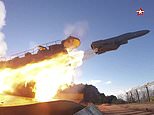Russia’s warning to US and Britain as it attacks ‘mock enemy’ off of Crimea
Russia’s warning to US and Britain as it attacks ‘mock enemy’ off of Crimea, four months after Royal Navy incident in same stretch of water
Russia issued a warning to the US and Britain to keep their distance from CrimeaA video showed a Russian war game involving an attack on a ‘mock enemy’20 warships and auxiliary vehicles were involved in the latest Russian exercisesComes four months after HMS Defender was warned away from the region
<!–
<!–
<!–<!–
<!–
(function (src, d, tag){
var s = d.createElement(tag), prev = d.getElementsByTagName(tag)[0];
s.src = src;
prev.parentNode.insertBefore(s, prev);
}(“https://www.dailymail.co.uk/static/gunther/1.17.0/async_bundle–.js”, document, “script”));
<!–
DM.loadCSS(“https://www.dailymail.co.uk/static/gunther/gunther-2159/video_bundle–.css”);
<!–
Russia has issued a chilling warning to the US and Britain after holding another set of war games and attacking a ‘mock enemy’ in the waters surrounding Crimea.
A Russian navy video shows missiles firing from the frigate Admiral Grigorovich and coastal anti-ship weapon systems against a ‘mock enemy’.
Some 20 warships and auxiliary vessels were involved in the latest exercises in and close to the Black Sea peninsula, annexed by Russia from Ukraine seven years ago.
The footage shows both Bal and Utes missile systems deployed in major drills off naval port Sevastopol.
A Black Sea Fleet video shows missile firing from frigate Admiral Grigorovich and coastal anti-ship weapon systems against a ‘mock enemy’
Some 20 warships and auxiliary vessels were involved in the latest exercises in and close to the Black Sea peninsula, annexed by Russia from Ukraine seven years ago
The crew of the frigate fired a Shtil anti-aircraft missile to strike down a Progress target missile mimicking an enemy attack, said reports.
It was hit at a distance of 25 miles, said the fleet.
Bal missile systems were deployed to destroy ‘a naval group of a simulated enemy’ both close and far from the coast, according to a TASS report citing naval sources.
This was the second week of war games in the area.
The video footage showed a number of different missile launchers firing rockets off out to sea during the war game
Close-up shots captured the missile launcher preparing to fire at the ‘mock enemy’
Britain has led NATO forces in sending patrols – including US and Dutch warships – close to Crimea.
In June, Russia even opened fire when the Royal Navy destroyed HMS Defender sailed off Crimea in a deliberate act of support for Ukraine.
A FSB security service coast guard vessel fired shots in the direction of the UK warship, claiming the vessel had sailed into Russian territorial waters.
Moscow also claimed to have dropped bombs from an Su-24 warplane in a bid to push the British ship away from the Crimean coast.
In June, Russia even opened fire when the Royal Navy destroyed HMS Defender sailed off Crimea in a deliberate act of support for Ukraine
Russia released footage filmed from one of its Su-24M attack jets which showed HMS Defender sailing off Crimea – but not the moment it alleges shots were fired and four bombs were dropped
A major diplomatic incident followed in which Boris Johnson defended the show of support for Ukraine as ‘entirely right’.
But there were Russian threats, including one from Mikhail Popov, deputy secretary of Russia’s Security Council, to sink the next Royal Navy warship to sail in the same waters.
The British warship, a Type 45 Destroyer, exercised what London said were internationally recognised freedom of navigation rules in Ukrainian territorial waters.
Russia protested strongly against the British move at the time with a coastguard vessel firing warning shots and summoned the British ambassador for an explanation.
A FSB security service coast guard vessel fired shots in the direction of the UK warship (circled), claiming the vessel had sailed into Russian territorial waters
Following the incident involving the HMS Defender (pictured), there were Russian threats, including one from Mikhail Popov, deputy secretary of Russia’s Security Council, to sink the next Royal Navy warship to sail in the same waters
Popov, in an interview in the state Rossiiyskaya Gazeta newspaper, said Britain’s behaviour and its subsequent reaction to the incident was ‘bewildering’.
In particular, he criticised suggestions from British Prime Minister Boris Johnson and Dominic Raab, the foreign minister, that the incident could be repeated.
‘Similar actions will be thwarted with the harshest methods in future by Russia regardless of the violator’s state allegiance. We suggest our opponents think hard about whether it’s worth organizing such provocations given the capabilities of Russia’s armed forces,’ said Popov.
‘It’s not the members of the British government who will be in the ships and vessels used for provocational ends,’ he added.
‘And it’s in that context that I want to ask a question of the same Boris Johnson and Dominic Raab – what will they say to the families of the British sailors who will get hurt in the name of such ‘great’ ideas?’.
![]()


